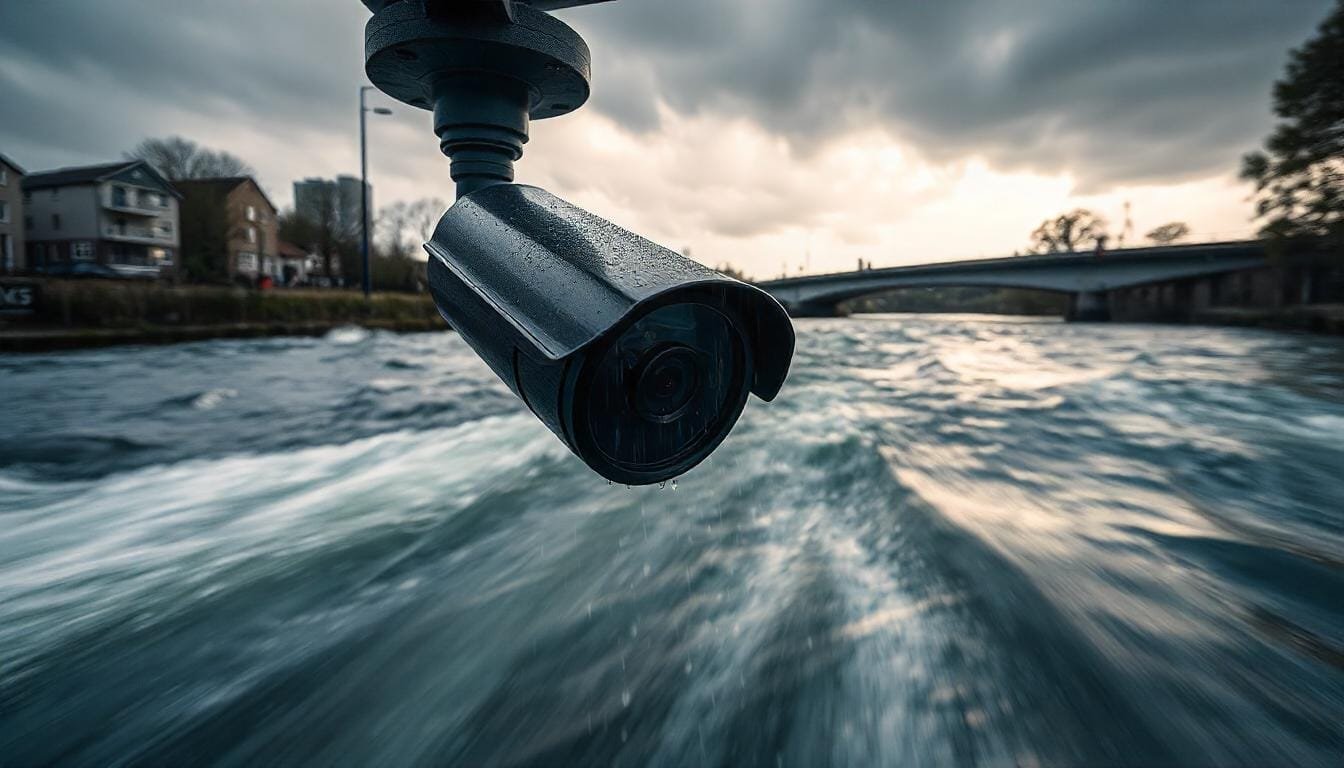Every year, UK rivers cause devastating floods that result in £1.4 billion worth of damage to homes and businesses. Currently, our traditional monitoring systems struggle to predict these disasters effectively.
However, we’ve discovered a groundbreaking solution that’s changing how we protect our communities.
As a result of recent technological advances, we’re now implementing sophisticated flood cameras across the UK’s river networks. These innovative systems include flood light cameras for night monitoring and flood watch cameras that provide real-time alerts. Our new network of flood monitoring cameras offers unprecedented visibility into river behavior, while live flood cameras enable immediate response to emerging threats. This article explores how this cutting-edge CCTV system is revolutionizing our approach to flood prevention and management in the UK.
Revolutionary AI Technology Transforms River Monitoring
Recent developments in artificial intelligence have led to a breakthrough in river monitoring technology. Researchers at the University of Bath have developed an innovative AI-powered CCTV system that identifies potential flood risks with nearly 90% accuracy.
The system, named ‘AI on the River,’ specifically targets culverts – man-made channels allowing rivers to flow under roads and urban infrastructure. Furthermore, this technology has been designed to integrate seamlessly with existing CCTV networks, making it both practical and cost-effective.
The system’s capabilities include:
- Real-time blockage detection
- Early warning alerts
- Automated monitoring of trash screens
- Debris identification
Additionally, this technology has demonstrated remarkable success through community involvement. In a groundbreaking initiative, the system was trained using 15,700 photographs submitted by citizen groups. These images helped develop AI models capable of identifying various indicators of river health, including wildlife presence, discharge points, and channel modifications.
Notably, this approach offers significant advantages over traditional monitoring methods. While conventional systems rely on expensive chemical and physical equipment that requires complex maintenance, our new flood monitoring cameras provide a more accessible solution. The technology has already attracted international attention, with flood prevention organizations in countries like South Africa showing interest in implementing similar systems.
The proactive nature of this system represents a fundamental shift in flood management. Rather than waiting for flooding to occur, these flood watch cameras can now alert authorities about potential blockages up to two weeks in advance, allowing for preventive action before emergency situations develop.
UK’s Critical Infrastructure Challenge
Managing the UK’s vast water infrastructure presents significant challenges for our flood prevention efforts. Presently, we maintain approximately 78,000 flood and coastal defense assets valued at £26 billion. Our infrastructure notably includes over one million culverts and outfalls across the country.
The scale of our challenge becomes evident when examining the flood risks. In England alone, approximately 3.4 million properties faced surface water flooding risks in 2022-2023. Consequently, maintaining these critical systems requires substantial resources, with channel maintenance costs ranging between £35 million and £55 million annually.
Our current infrastructure faces several pressing challenges:
- Traditional monitoring methods require expensive specialized equipment
- Manual water sample collection is time-consuming and labor-intensive
- Channel maintenance represents 35% of total expenditure for Internal Drainage Boards
- Climate change significantly intensifies existing pressures on water infrastructure
To address these challenges, we’re implementing flood monitoring cameras and flood watch cameras across critical points in our infrastructure network. These systems are particularly vital for urban areas, where culvert or bridge blockages can have severe consequences. Through live flood cameras, we can now monitor these crucial points continuously, significantly improving our ability to prevent flooding incidents.
The Environment Agency protects approximately 2,000 culverts, spanning over 200 kilometers, alongside maintaining roughly 2,800 screens. Through innovative technologies like flood light cameras, we’re enhancing our capability to monitor these assets effectively, particularly during nighttime and adverse weather conditions.
Climate Change Adaptation Through Technology
Climate change continues to intensify adverse effects on our waterways, with extreme rainfall events now occurring once per decade instead of once every 100 years in many populated areas. Moreover, we’re witnessing unprecedented changes in weather patterns that demand innovative solutions for flood management.
Our implementation of advanced flood monitoring cameras has become essential in addressing these challenges. Currently, these systems offer real-time data and insights through:
- Water level monitoring
- Flow velocity tracking
- Rainfall measurement
- Environmental area protection
Indeed, these flood watch cameras have proven invaluable for urban planning and policy development. The integration of our live flood cameras with AI-driven analysis enables processing of multiple data sources simultaneously, including satellite imagery, weather forecasts, and historical flood records.
Notably, our flood light cameras are part of a comprehensive monitoring network that helps authorities make informed decisions. This technology has demonstrated remarkable success, with AI models processing vast datasets to generate short-term forecasts that are crucial for effective flood response.
The system’s effectiveness extends beyond mere monitoring. Through our network of flood cameras, we can now identify patterns and correlations within the data that might be missed by human analysts. This capability is especially valuable in areas where traditional monitoring methods prove insufficient or cost-prohibitive.
Conclusion
All things considered, our new CCTV system marks a significant step forward in protecting UK communities from flood risks. The combination of AI-powered cameras and citizen participation has created a robust early warning system that spots potential dangers two weeks before they become emergencies. Above all, the system’s 90% accuracy rate proves its reliability in safeguarding our £26 billion worth of flood defense infrastructure.
The success of this technology stems from its practical approach to modern challenges. These smart cameras now watch over our one million culverts and outfalls, sending instant alerts about potential blockages. Therefore, our response teams can act quickly, preventing the £1.4 billion yearly damage that floods typically cause to homes and businesses.
Climate change continues to test our flood defense capabilities. Consequently, this advanced monitoring network serves as a crucial tool in our ongoing efforts to protect communities. The system’s ability to process multiple data streams while providing real-time insights has transformed our approach to flood management, making UK rivers safer for everyone.


